The Mass Balance of Glacier No. 1 at the Headwaters of the Urumqi River in Relation to Northern Hemisphere Teleconnection Patterns
Abstract
:1. Introduction
2. Study Area and Methods
2.1. Study Area and Data
2.2. Methods
3. Results and Discussion
3.1. The Change in the Mass Balance of Glacier No. 1
3.2. Relationships between the Mass Balance of Glacier No. 1 and Teleconnection Patterns
4. Conclusions
Acknowledgments
Author Contributions
Conflicts of Interest
References
- Dyurgerov, M.B.; Meier, M.F. Twentieth century climate change: Evidence from small glaciers. P. Natl. Acad. Sci. USA 2000, 97, 1406–1411. [Google Scholar] [CrossRef]
- Diolaiuti, G.A.; Bocchiola, D.; Vagliasindi, M.; D’Agata, C.; Smiraglia, C. The 1975–2005 glacier changes in aosta valley (italy) and the relations with climate evolution. Prog. Phys. Geogr. 2012, 36, 764–785. [Google Scholar] [CrossRef]
- Aizen, V.; Aizen, E.; Melack, J.; Martma, T. Isotopic measurements of precipitation on central asian glaciers (southeastern tibet, northern himalayas, central tien shan). J. Geophys. Res. Atmos. 1996, 101, 9185–9196. [Google Scholar] [CrossRef]
- Bitz, C.M.; Battisti, D.S. Interannual to decadal variability in climate and the glacier mass balance in washington, western canada, and alaska. J. Clim. 1999, 12, 3181–3196. [Google Scholar] [CrossRef]
- Moore, R.D.; Demuth, M.N. Mass balance and streamflow variability at place glacier, canada, in relation to recent climate fluctuations. Hydrol. Process. 2001, 15, 3473–3486. [Google Scholar] [CrossRef]
- Washington, R.; Hodson, A.; Isaksson, E.; MacDonald, O. Northern hemisphere teleconnection indices and the mass balance of svalbard glaciers. Int. J. Climatol. 2000, 20, 473–487. [Google Scholar] [CrossRef]
- Leathers, D.J.; Yarnal, B.; Palecki, M.A. The pacific north-american teleconnection pattern and united-states climate. Part I. Regional temperature and precipitation associations. J. Clim. 1991, 4, 517–528. [Google Scholar] [CrossRef]
- Jiang, P.; Gautam, M.R.; Zhu, J.; Yu, Z. How well do the GCMs/RCMs capture the multi-scale temporal variability of precipitation in the southwestern united states? J. Hydrol. 2013, 479, 75–85. [Google Scholar] [CrossRef]
- Luo, P.; Apip; He, B.; Duan, W.; Takara, K.; Nover, D. Impact assessment of rainfall scenarios and land-use change on hydrologic response using synthetic area idf curves. J. Flood Risk Manag. 2015. [Google Scholar] [CrossRef]
- Chaffe, P.L.B.; Takara, K.; Yamashiki, Y.; Apip; Luo, P.; Silva, R.V.; Nakakita, E. Mapping of japanese areas susceptible to snow cover change. Hydrol. Sci. J. 2013, 58, 1718–1728. [Google Scholar] [CrossRef]
- Luo, P.; Takara, K.; Apip; He, B.; Nover, D. Palaeoflood simulation of the kamo river basin using a grid-cell distributed rainfall run-off model. J. Flood Risk Manag. 2014, 7, 182–192. [Google Scholar] [CrossRef]
- Luo, P.P.; He, B.; Takara, K.; Xiong, Y.E.; Nouer, D.; Duan, W.L.; Fukushi, K. Historical assessment of chinese and japanese flood management policies and implications for managing future floods. Environ. Sci. Policy 2015, 48, 265–277. [Google Scholar] [CrossRef]
- Li, Z.Q.; Wang, W.B.; Zhang, M.J.; Wang, F.T.; Li, H.L. Observed changes in streamflow at the headwaters of the urumqi river, eastern tianshan, central asia. Hydrol. Process. 2010, 24, 217–224. [Google Scholar] [CrossRef]
- Ye, B.S.; Yang, D.Q.; Jiao, K.Q.; Han, T.D.; Jin, Z.F.; Yang, H.A.; Li, Z.Q. The Urumqi River source Gacier No. 1, Tianshan, China: Changes over the past 45 years. Geophys. Res. Lett. 2005, 32. [Google Scholar] [CrossRef]
- Han, T.D.; Ding, Y.J.; Ye, B.S.; Jiao, K.Q. Characteristics of winter mass balance of Glacier No.1 at the headwaters of the urumqi river, tianshan mountains. Environ. Earth Sci. 2011, 63, 695–700. [Google Scholar] [CrossRef]
- Wu, L.; Li, H.; Wang, L. Application of a degree-day model for determination of mass balance of urumqi Glacier No. 1, eastern Tianshan, China. J. Earth Sci. 2011, 22, 470–481. [Google Scholar] [CrossRef]
- Li, Z.; Li, H.; Chen, Y. Mechanisms and simulation of accelerated shrinkage of continental glaciers: A case study of Urumqi Glacier No. 1 in eastern Tianshan, central Asia. J. Earth Sci. 2011, 22, 423–430. [Google Scholar] [CrossRef]
- Xu, X.; Pan, B.; Hu, E.; Li, Y.; Liang, Y. Responses of two branches of Glacier No. 1 to climate change from 1993 to 2005, Tianshan, China. Quat. Int. 2011, 236, 143–150. [Google Scholar] [CrossRef]
- Cui, Y.H.; Ye, B.S.; Wang, J.; Liu, Y.C. Influence of degree-day factor variation on the mass balance of Glacier No. 1 at the headwaters of Urumqi River, China. J. Earth Sci. 2013, 24, 1008–1022. [Google Scholar] [CrossRef]
- Gao, M.J.; Han, T.D.; Ye, B.S.; Jiao, K.Q. Characteristics of melt water discharge in the Glacier No. 1 basin, headwater of Urumqi River. J. Hydrol. 2013, 489, 180–188. [Google Scholar]
- Wang, P.Y.; Li, Z.Q.; Li, H.L.; Wang, W.B.; Yao, H.B. Comparison of glaciological and geodetic mass balance at Urumqi Glacier No. 1, Tianshan, central Asia. Glob. Planet Chang. 2014, 114, 14–22. [Google Scholar] [CrossRef]
- Diolaiuti, G.; Bocchiola, D.; D’agata, C.; Smiraglia, C. Evidence of climate change impact upon glaciers’ recession within the Italian Alps. Theor. Appl. Climatol. 2012, 109, 429–445. [Google Scholar] [CrossRef]
- Sun, M.P.; Yao, X.J.; Li, Z.Q.; Zhang, M.J. Hydrological processes of glacier and snow melting and runoff in the Urumqi River source region, eastern Tianshan mountains, China. J. Geogr. Sci. 2015, 25, 149–164. [Google Scholar] [CrossRef]
- Xu, X.K.; Pan, B.L.; Hu, E.; Li, Y.J.; Liang, Y.H. Responses of two branches of Glacier No. 1 to climate change from 1993 to 2005, Tianshan, China. Quat. Int. 2011, 236, 143–150. [Google Scholar] [CrossRef]
- Williams, M.W.; Tonnessen, K.A.; Melack, J.M.; Yang, D.Q. Sources and spatial variation of the chemical-composition of snow in the Tien Shan, China. Ann. Glaciol. 1992, 16, 25–32. [Google Scholar]
- Li, X.; Li, Z.; Ding, Y.; Liu, S.; Zhao, Z.; Luo, L.; Pang, H.; Li, C.; Li, H.; You, X.; et al. Seasonal variations of ph and electrical conductivity in a snow-firn pack on Glacier No. 1, eastern Tianshan, China. Cold Reg. Sci. Technol. 2007, 48, 55–63. [Google Scholar] [CrossRef]
- Tian, L.; Yao, T.; MacClune, K.; White, J.W.C.; Schilla, A.; Vaughn, B.; Vachon, R.; Ichiyanagi, K. Stable isotopic variations in west China: A consideration of moisture sources. J. Geophys. Res. 2007, 112. [Google Scholar] [CrossRef]
- Zhang, G.F.; Li, Z.Q.; Wang, W.B.; Wang, W.D. Rapid decrease of observed mass balance in the Urumqi Glacier No. 1, Tianshan mountains, central Asia. Quat. Int. 2014, 349, 135–141. [Google Scholar] [CrossRef]
- Barnston, A.G.; Livezey, R.E. Classification, seasonality and persistence of low-frequency atmospheric circulation patterns. Mon. Weather Rev. 1987, 115, 1083–1126. [Google Scholar] [CrossRef]
- Burn, D.H.; Elnur, M.A.H. Detection of hydrologic trends and variability. J. Hydrol. 2002, 255, 107–122. [Google Scholar] [CrossRef]
- Westmacott, J.R.; Burn, D.H. Climate change effects on the hydrologic regime within the churchill-nelson river basin. J. Hydrol. 1997, 202, 263–279. [Google Scholar] [CrossRef]
- Luo, P.P.; He, B.; Chaffe, P.L.B.; Nover, D.; Takara, K.; Rozainy, M.A.Z.M.R. Statistical analysis and estimation of annual suspended sediments of major rivers in Japan. Environ. Sci. Process Impact 2013, 15, 1052–1061. [Google Scholar] [CrossRef] [PubMed]
- Luo, P.P.; He, B.; Takara, K.; Razafindrabe, B.H.N.; Nover, D.; Yamashiki, Y. Spatiotemporal trend analysis of recent river water quality conditions in Japan. J. Environ. Monit. 2011, 13, 2819–2829. [Google Scholar] [CrossRef] [PubMed] [Green Version]
- Taylor, W.A. Change-Point Analysis: A Powerful New Tool for Detecting Changes. Available online: http://www.variation.com/cpa/tech/changepoint.html (accessed on 31 December 2014).
- Collins, K.; Hunt, W.; Hathaway, J. Hydrologic comparison of four types of permeable pavement and standard asphalt in eastern North Crolina. J. Hydrol. Eng. 2008, 13, 1146–1157. [Google Scholar] [CrossRef]
- Fischer, T.; Gemmer, M.; Liu, L.; Su, B. Change-points in climate extremes in the Zhujiang River basin, south China, 1961–2007. Clim. Chang. 2012, 110, 783–799. [Google Scholar] [CrossRef]
- Mavromatis, T.; Stathis, D. Response of the water balance in greece to temperature and precipitation trends. Theor. Appl. Climatol. 2011, 104, 13–24. [Google Scholar] [CrossRef]
- Rana, A.; Uvo, C.B.; Bengtsson, L.; Sarthi, P.P. Trend analysis for rainfall in delhi and mumbai, india. Clim. Dyn. 2012, 38, 45–56. [Google Scholar] [CrossRef]
- Uvo, C.B. Analysis and regionalization of northern european winter precipitation based on its relationship with the north atlantic oscillation. Int. J. Climatol. 2003, 23, 1185–1194. [Google Scholar] [CrossRef]
- Wallace, J.M.; Smith, C.; Bretherton, C.S. Singular value decomposition of wintertime sea-surface temperature and 500-mb height anomalies. J. Clim. 1992, 5, 561–576. [Google Scholar] [CrossRef]
- Uvo, C.B.; Repelli, C.A.; Zebiak, S.E.; Kushnir, Y. The relationships between tropical pacific and atlantic sst and northeast brazil monthly precipitation. J. Clim. 1998, 11, 551–562. [Google Scholar] [CrossRef]
- Bretherton, C.S.; Smith, C.; Wallace, J.M. An intercomparison of methods for finding coupled patterns in climate data. J. Clim. 1992, 5, 541–560. [Google Scholar] [CrossRef]
- Liu, Q.; Liu, S. Response of glacier mass balance to climate change in the tianshan mountains during the second half of the twentieth century. Clim. Dyn. 2015, 46, 303–316. [Google Scholar] [CrossRef]
- Bueh, C.; Nakamura, H. Scandinavian pattern and its climatic impact. Q. J. R. Meteor. Soc. 2007, 133, 2117–2131. [Google Scholar] [CrossRef]
- Feng, F.; Li, Z.Q.; Zhang, M.J.; Jin, S.; Dong, Z.W. Deuterium and oxygen 18 in precipitation and atmospheric moisture in the upper urumqi river basin, eastern tianshan mountains. Environ. Earth Sci. 2013, 68, 1199–1209. [Google Scholar] [CrossRef]
- Yang, W.; Guo, X.; Yao, T.; Zhu, M.; Wang, Y. Recent accelerating mass loss of southeast tibetan glaciers and the relationship with changes in macroscale atmospheric circulations. Clim. Dyn. 2015, 1–11. [Google Scholar] [CrossRef]
- Bothe, O.; Fraedrich, K.; Zhu, X.H. Precipitation climate of central Asia and the large-scale atmospheric circulation. Theor. Appl. Climatol. 2012, 108, 345–354. [Google Scholar] [CrossRef]
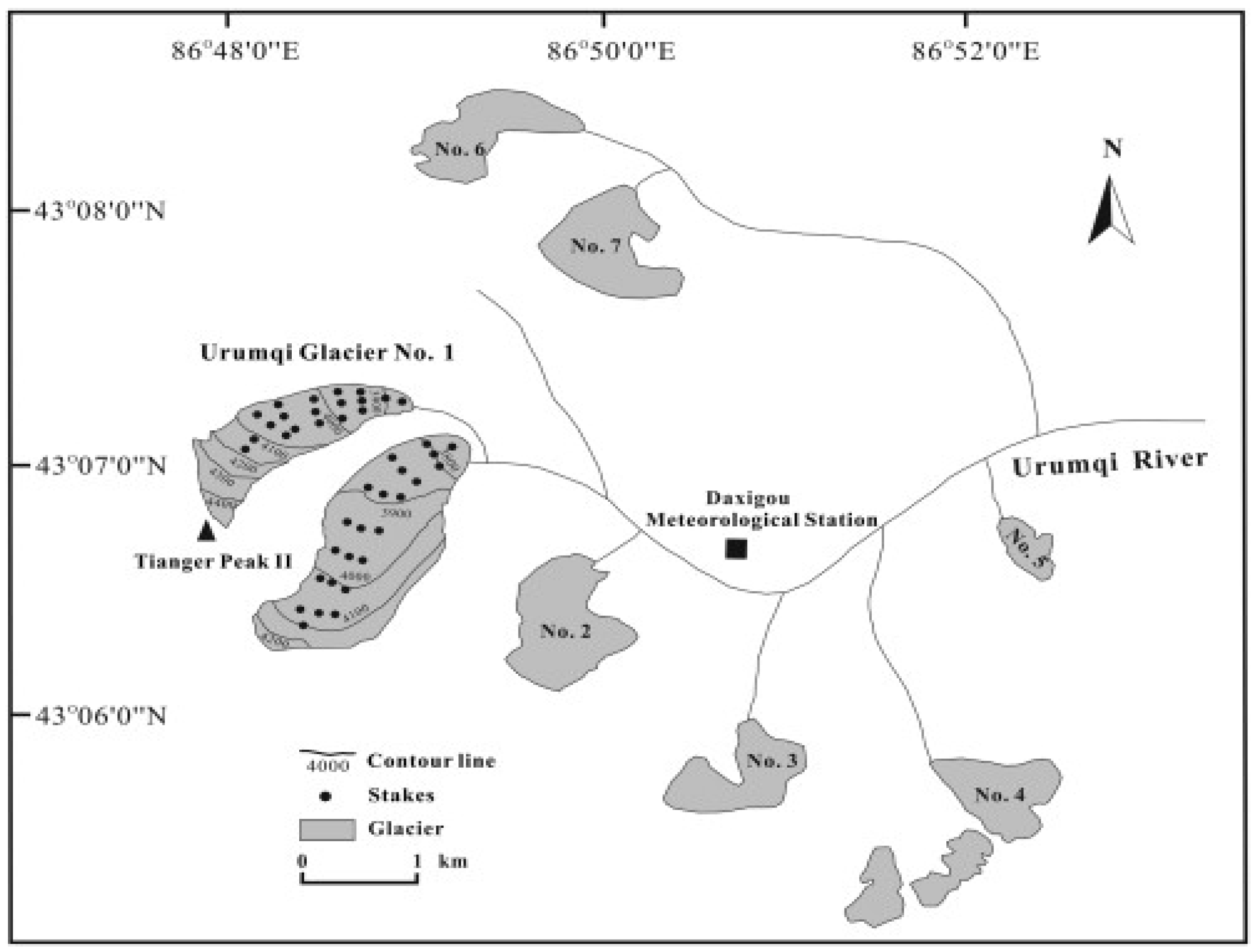
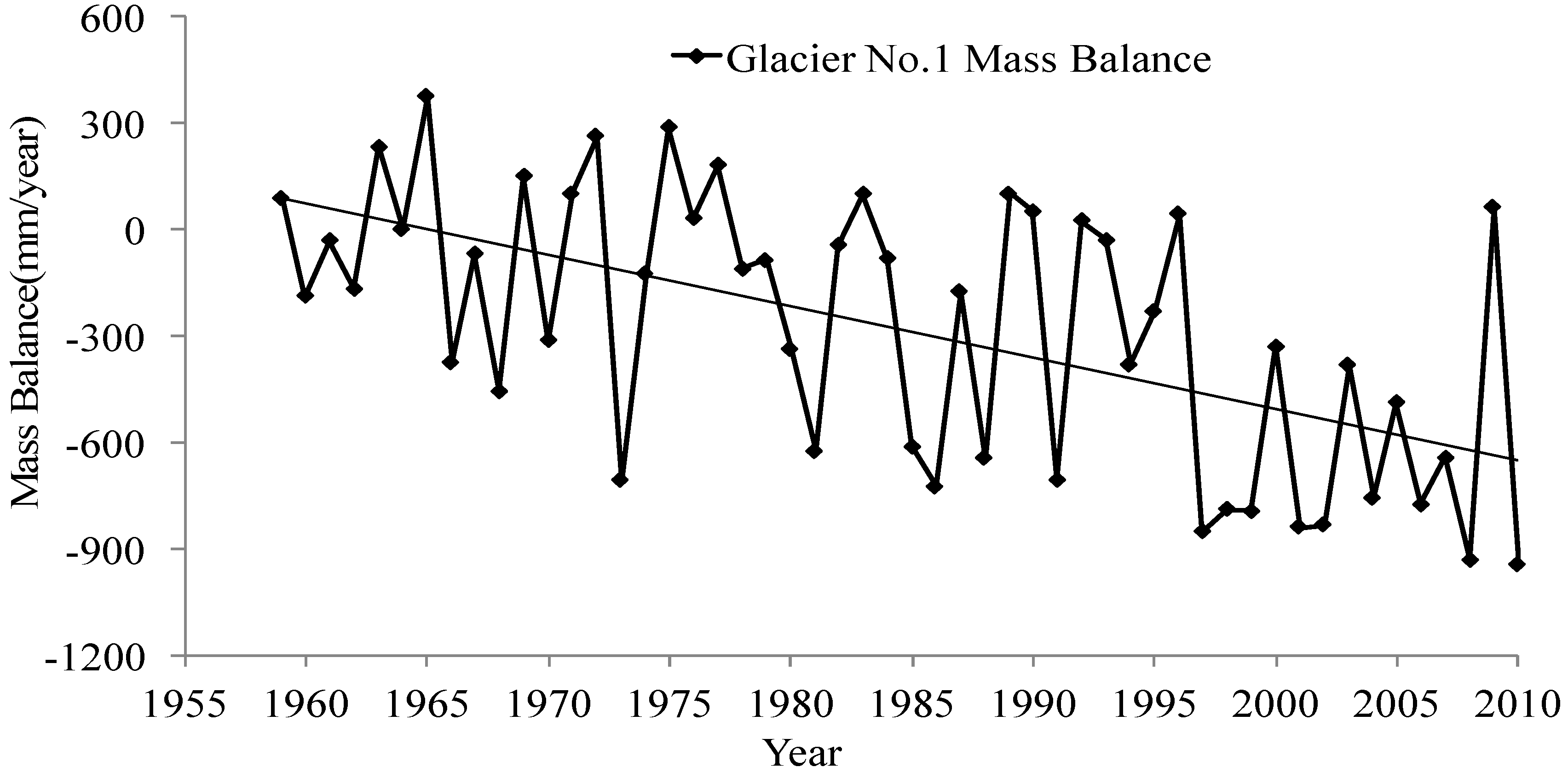
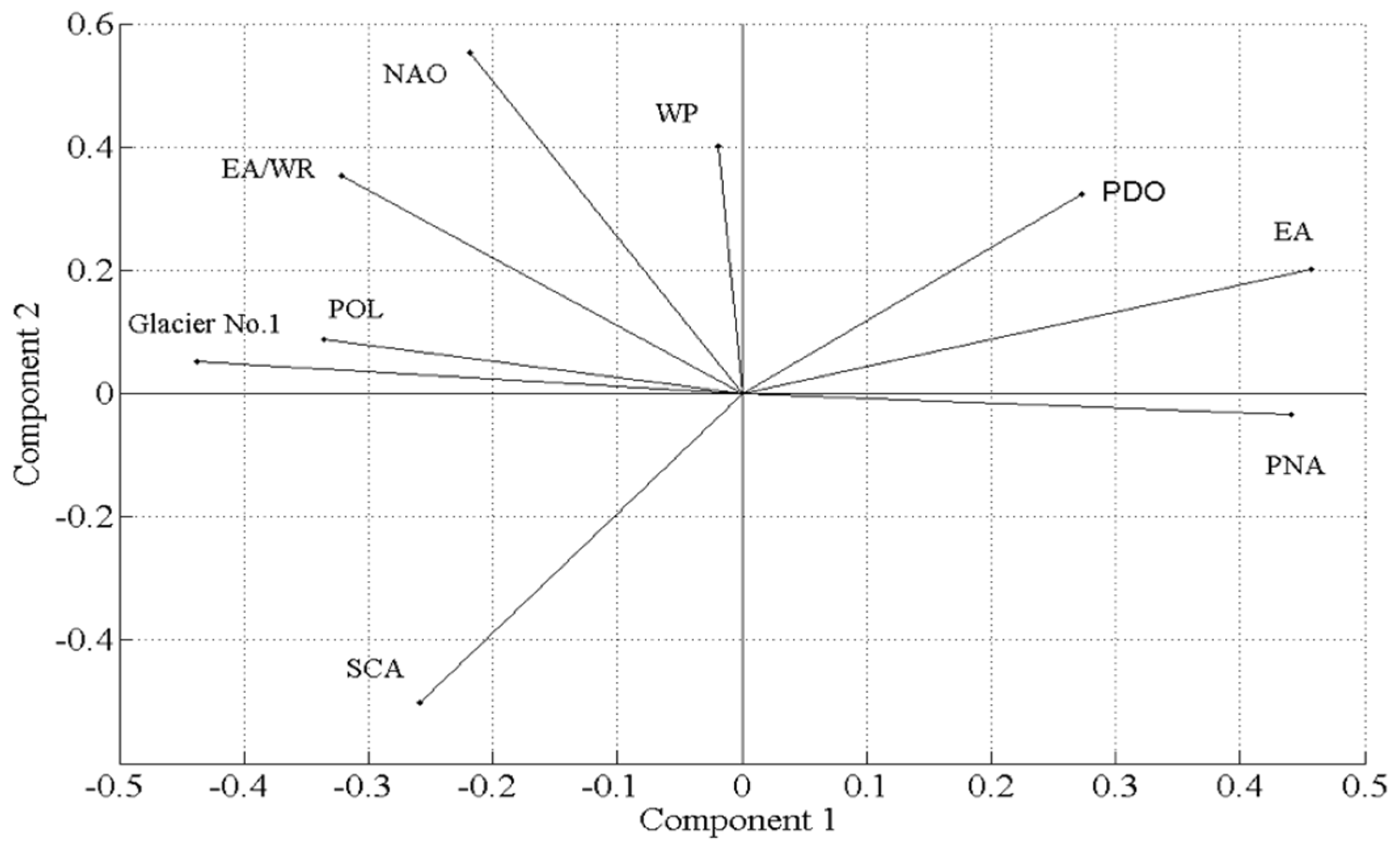
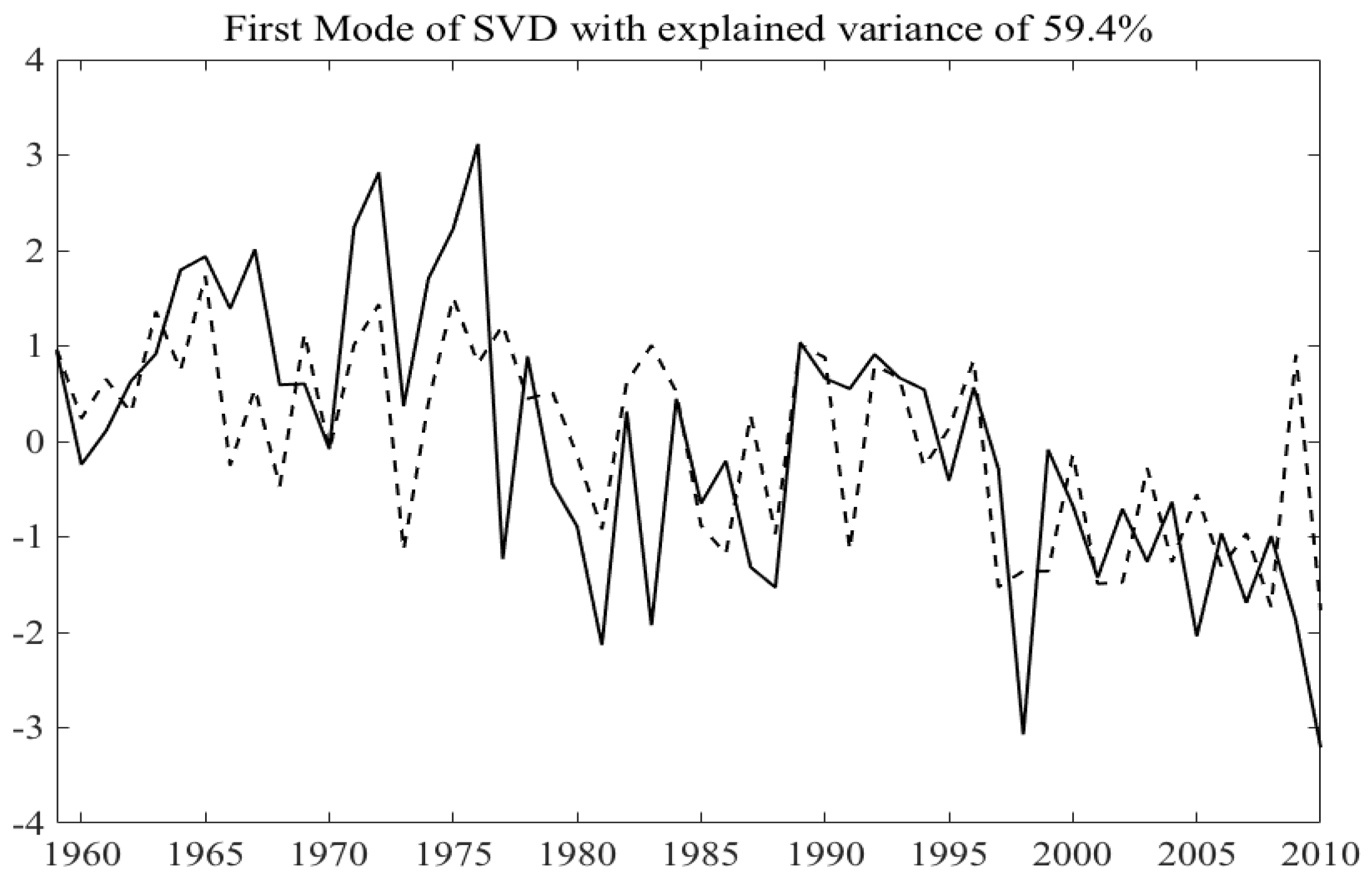
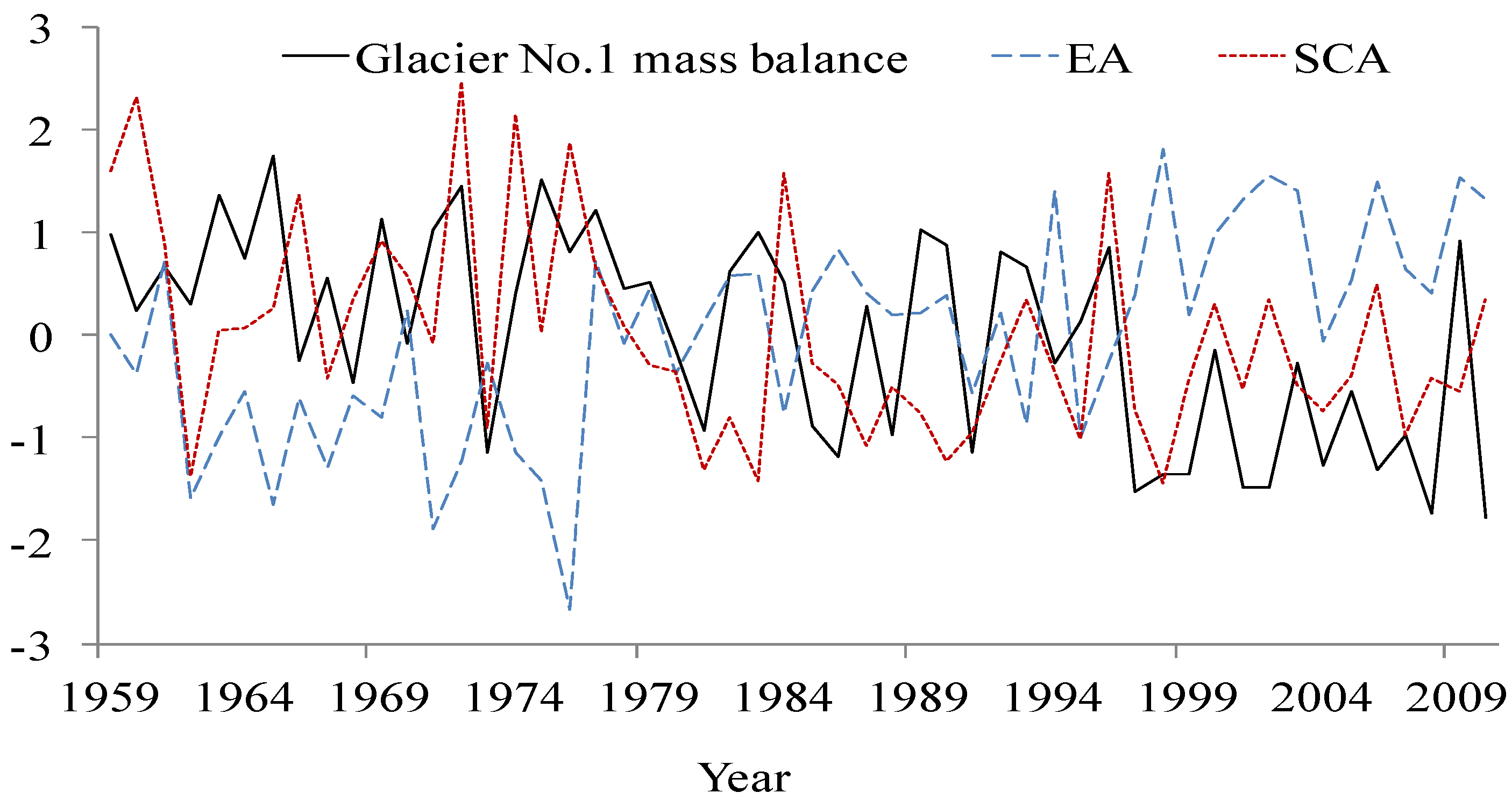
| Change Point Analyzer | Change Point | Confidence Pevel (%) | Mass Plance (1959–1996) | Mass Palance (1997–2010) | Accumulated Pass Palance |
|---|---|---|---|---|---|
| Mass balance | 1997 | 99 | −136.4 mm/year | −663.9 mm/year | −14479 mm |
| Mode | Glacier No. 1 | NAO | EA | WP | PNA | EA/WR | SCA | POL | PDO |
|---|---|---|---|---|---|---|---|---|---|
| Mode1 | 0.594 | 0.277 | −0.517 | 0.109 | −0.323 | 0.273 | 0.344 | 0.241 | −0.092 |
© 2016 by the authors; licensee MDPI, Basel, Switzerland. This article is an open access article distributed under the terms and conditions of the Creative Commons by Attribution (CC-BY) license (http://creativecommons.org/licenses/by/4.0/).
Share and Cite
Yuan, F.; Hao, Z.; Berndtsson, R.; Jiang, P.; Yasuda, H. The Mass Balance of Glacier No. 1 at the Headwaters of the Urumqi River in Relation to Northern Hemisphere Teleconnection Patterns. Water 2016, 8, 100. https://doi.org/10.3390/w8030100
Yuan F, Hao Z, Berndtsson R, Jiang P, Yasuda H. The Mass Balance of Glacier No. 1 at the Headwaters of the Urumqi River in Relation to Northern Hemisphere Teleconnection Patterns. Water. 2016; 8(3):100. https://doi.org/10.3390/w8030100
Chicago/Turabian StyleYuan, Feifei, Zhenchun Hao, Ronny Berndtsson, Peng Jiang, and Hiroshi Yasuda. 2016. "The Mass Balance of Glacier No. 1 at the Headwaters of the Urumqi River in Relation to Northern Hemisphere Teleconnection Patterns" Water 8, no. 3: 100. https://doi.org/10.3390/w8030100
APA StyleYuan, F., Hao, Z., Berndtsson, R., Jiang, P., & Yasuda, H. (2016). The Mass Balance of Glacier No. 1 at the Headwaters of the Urumqi River in Relation to Northern Hemisphere Teleconnection Patterns. Water, 8(3), 100. https://doi.org/10.3390/w8030100







